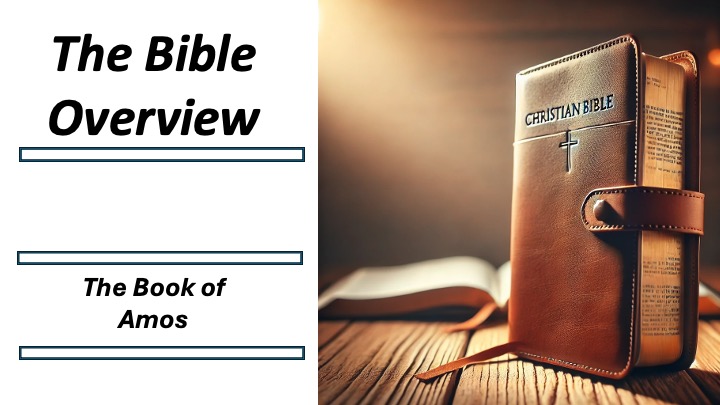Bible Overview Amos
Mike Ervin

The Book of Amos: Overview
Authorship
Traditional View:
• The book is attributed to Amos, a shepherd and fig farmer from Tekoa (Amos
1:1).
• He was not a professional prophet but was called by God to deliver His
message.
• His prophetic ministry was primarily directed toward the northern kingdom of
Israel.
Modern Scholarly View:
• Most scholars accept Amos as a historical figure and that the core of the
book comes from his actual oracles.
• Some believe later editors may have expanded the book to address post-exilic
concerns.
Date of Authorship
• Traditional View:
• Amos prophesied during the reigns of Uzziah of Judah (792–740 BC) and
Jeroboam II of Israel (793–753 BC) (Amos 1:1).
• This would place his ministry around 760–750 BC, during a time of prosperity
and corruption in Israel.
• Modern View:
• Most scholars agree with the traditional dating (8th century BC).
• Some suggest later editorial additions, especially in Amos 9, to address the
fall of Samaria (722 BC) and Judah’s exile (586 BC).
Intended Audience
• Primarily addressed to the northern kingdom of Israel.
• Also contains judgments against surrounding nations (Amos 1–2).
• Aimed at the wealthy elite, corrupt leaders, and complacent religious
figures.
Major Themes
1. Social Justice – Condemns the oppression of the poor and the corruption of
the elite (Amos 2:6-7, 5:11-12).
2. Divine Judgment – Warns of coming disaster for Israel due to its sins (Amos
4:6-12, 5:18-20).
3. True Worship vs. Empty Rituals – Criticizes insincere religious practices
without justice (Amos 5:21-24).
4. The Day of the Lord – A day of judgment rather than blessing for sinful
Israel (Amos 5:18-20).
5. God’s Sovereignty Over All Nations – Judgment extends beyond Israel to all
nations (Amos 1–2).
6. Hope for Restoration – Despite judgment, a remnant will be restored (Amos
9:11-15).
Chapter-by-Chapter Summary
I. Oracles Against Nations (Ch. 1–2)
• Ch. 1–2 – Judgment is pronounced against Israel’s neighbors (Damascus, Gaza,
Tyre, Edom, Ammon, Moab) and against Judah and Israel.
II. Condemnation of Israel’s Sins (Ch. 3–6)
• Ch. 3 – Israel’s election comes with responsibility; they failed.
• Ch. 4 – Warnings through past disasters; “Prepare to meet your God.”
• Ch. 5 – A call to repentance; God rejects empty worship.
• Ch. 6 – Judgment on the complacent wealthy elite.
III. Visions of Judgment (Ch. 7–9)
• Ch. 7 – Amos sees visions of destruction (locusts, fire, plumb line).
• Ch. 8 – A vision of a basket of ripe fruit (symbolizing impending doom).
• Ch. 9 – Judgment is certain, but a remnant will be restored.